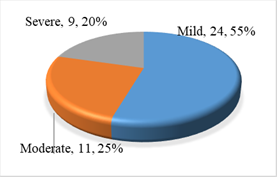Status of carotid artery atherosclerosis among the ischemic stroke patients
Abstract
Background: Carotid artery atherosclerosis is a widespread pathological condition and one of the most significant risk factors for the development of ischemic stroke. The risk of ischemic stroke increases with the increase in the degree of carotid artery atherosclerosis. Aim of the study: This study aimed to assess the status of carotid artery atherosclerosis among ischemic stroke patients. Methods: This descriptive cross-sectional study was conducted in the Department of Neurology of Sir Salimullah Medical College & Mitford Hospital (MH), Dhaka, Bangladesh for one year. In total 70 ischemic stroke patients were selected as the study subjects according to the selection criteria. Written informed consents were taken from all the study subjects. Data were analyzed using statistical program SPSS 20.0. Results: Among stroke patients, 62.9% had carotid stenosis. Among stroke patients 34.3% had mild, 15.7% had moderate and 12.9% had severe carotid stenosis. The degree of stenosis of carotid arteries increased with increasing of age. Most common associated risk factor was DM (64.3%) followed by HTN (45.7%), smoking (37.5%), and dyslipidemia (30.0%). Obesity was observed in 13 (18.6%) cases, MI in 11 (15.7%) cases, CKD in 4 (5.7%) cases and electrolyte imbalance in 3 (4.3%) cases. Majority of the plaques were found in the carotid bulbs (32.3%), followed by common carotid artery (29.0%), internal carotid artery (22.6%), and common carotid artery bifurcation (12.9%) and external carotid artery (3.2%). The majority of the plaques were homogenous (59.7%) followed by heterogenous (17.7%), calcified (17.7%) and ulcerated (4.8%) plaques. Conclusion: Carotid artery stenosis is common in ischemic stroke patients. Diabetes mellitus, HTN and smoking are the most common risk factors in ischemic stroke patients. The majority of the plaques are found in carotid bulb and most of the plaques are usually homogenous.
Downloads
References
Wang, H. et al. (2016) ‘Global, regional, and national life expectancy, all-cause mortality, and cause-specific mortality for 249 causes of death, 1980–2015: a systematic analysis for the Global Burden of Disease Study 2015’, The Lancet, 388(10053), pp. 1459–544.
Taylor, K.J.W., Burn, P.N., Wells, P.N.T. 1995 ‘Clinical application of Doppler ultrasound,’ Raven Ltd. New York, pp. 1-128.
Pohl, M.I. (1994) ‘Carotid artery disease,’ Optom-Clin, 3(4), pp. 157-74.
Rothwell, PM. et al. (2000) ‘Evidence of a chronic systemic cause of instability of atherosclerotic plaques,’ Lancet, 355, pp. 19–24.
Roger, V. L, et al. (2011) ‘Heart disease and stroke statistics--2011 update: a report from the American Heart Association.’, Circulation. NIH Public Access, 123(4), pp. e18–e209.
Khattak MI, Khan F, Fida Z, Zar A. Carotid artery stenosis; in ischemic stroke patients. Professional Med J 2017;24(8):1126-1131. DOI: 10.17957/TPMJ/17.4064.
Sillesen H, Amarenco P, Hennerici MG, Callahan A, Goldstein LB, Zivin J, et al. Atorvastatin reduces the risk of cardiovascular events in patients with carotid atherosclerosis: a secondary analysis of the Stroke Prevention by Aggressive Reduction in Cholesterol Levels (SPARCL) trial. Stroke 2008; 39:3297-302.
Dharmasaroja P. Prevalence of extracranial carotid stenosis in Thai ischemic stroke/TIA patients. Journal of the neurological sciences 2008; 269:92-5.
Haq, S., Mathur, M., Singh, J., Kaur, N., Sibia, R.S. and Badhan, R. (2017) ‘Colour Doppler Evaluation of Extracranial Carotid Artery in Patients Presenting with Acute Ischemic Stroke and Correlation with Various Risk Factors’, Journal of Clinical and Diagnostic Research, 11(3), p. TC01-TC05.
Harris, S., (2012) The association of carotid intima-media thickness (cIMT) and stroke: A cross sectional study.Perspectives in Medicine, 1(1-12), pp.164-66.
Kitamura, A., Iso, H., Imano, H. and Ohira, T. (2004) ‘Carotid Intima-Media Thickness and Plaque Characteristics as a Risk Factor for Stroke in Japanese Elderly Men’, Stroke, 35, pp. 2788–794.
Arima, H., Chalmers, J., Woodward, M., Anderson, C., Rodgers, A., Davis, S., MacMahon, S., Neal, B. and PROGRESS Collaborative Group. (2006) ‘Lower target blood pressures are safe and effective for the prevention of recurrent stroke: the PROGRESS trial’, Journal of hypertension, 24(6), pp. 1201-1208.
Tuttolomondo, A., Maida, C., Maugeri, R., Iacopino, G. and Pinto, A. (2015) ‘Relationship between diabetes and ischemic stroke: Analysis of diabetes-related risk factors for stroke and of specific patterns of stroke associated with diabetes mellitus’, Diabetes and Metabolism Journal, 6(5), pp.1-7.
Sultana, N., Bari, A. K.M.F., Majumder, T.K., Islam, R., Hossain, F.A.R.A. and Alam, F. (2012) ‘Duplex Study of Carotid Artery in Patients with Ischemic Stroke’, Bangladesh Journal of Neuroscience, 28(2), pp. 67–73.
Živadinović, B, et al. (2016) ‘Carotid Artery Stenosis As a Risk Factor for the Occurrence of Ischemic Stroke.’, Acta Medica Medianae,55(2), pp. 40–45.
Garg, S., Kashikar, S.V. and Phatak, S. (2016) ‘Colour doppler evaluation of extracranial carotid arteries: A clinical and radiological correlation’, J Clin and Diag Res, 10(1), p. TC06-TC10.



























